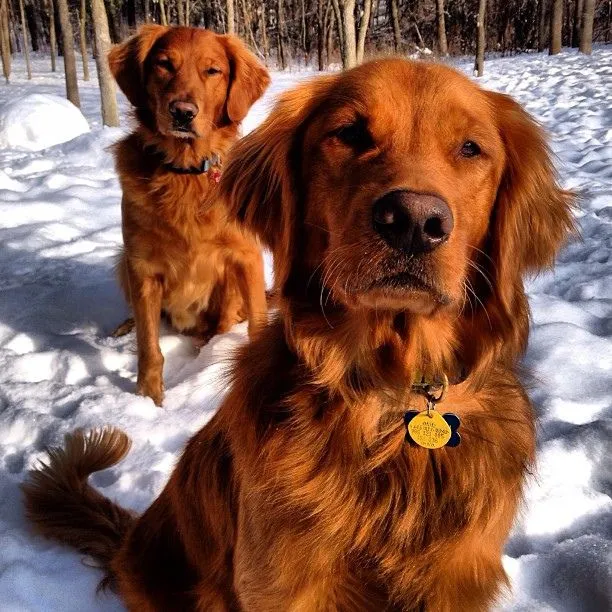Introduction:
The Red Golden Retriever, or Dark Golden Retriever and Mahogany Golden Retriever. Which is a distinguishing variant crossbreed within the breed of Golden Retriever. This has captivated the hearts of many dog fans worldwide owing to its luscious coat extending from deep golden hues to rich reddish. The origins, characteristics, health considerations, and popularity of the Red Golden Retriever, are explored in this article supported by some realistic analytical data. The story of red golden retrievers started back in the 19th century from Scotland when Lord Tweedmouth, also known as Dudley Marjoribanks, decided to develop a straonger golden breeder dog breed for hunting expeditions. For this, he crossed a Yellow Retriever with a now-extinct Tweed Water Spaniel. This resulted in a new breed that is known as Red Golden Retrievers.
Genetic factors are prominent in distinctive reddish hue of the Red Golden Retriever's coat. Variations of genes are primarily responsible for skin-color that led to differences in coat pattern. For example, colors observed in Golden Retrievers are due to variations in the melanin-producing genes, including MC1R and TYRP1, contribute to the range of, including shades of red. While, the recessive genes responsible for the red coat and the classic golden color is prevalent, resulting in the striking mahogany hues characteristic of this breed. First, this dog breed's red color captures every pet lover’s attention. The red coat makes this dog look distinctive from other breeds. That's one primary reason why red retrievers are so much loved by the pet community.
As his classic counterparts, thye share many traits with them. This breed is also intelligent, loyal, and a gentle. They are proved very smart in many canine sports even as therapy dogs, due to their trainable nature and eagerness to please. They are excellent companions for individuals and families alike owing to affectionate disposition makes them. They exhibit high levels of energy, so they also require regular exercise and mental stimulation. This dog is very friendly and versatile; it can adapt to different environments. In addition, you can train it as a family dog.
Health Concerns:
This canine variation is also prone to certain health conditions like all dog breeds, some of which may be caused by genetics. Hip dysplasia, elbow dysplasia, heart disease and even cancer are some of the common health concerns observed in Golden Retrievers, including hereditary eye conditions. Promoting the overall health and well-being of the breed, responsible breeding practices, including health screenings and genetic testing, are essential for minimizing the risk of hereditary diseases and. heart disease and cancer are significant health concerns in this breed.
- Hip Dysplasia: is a communal orthopedic condition, which is characterized by abnormal development of the hip joint. That can even lead to lameness, discomfort, and impaired mobility. They are also predisposed to hip dysplasia having a large size and genetic reasons. There are some pre-diagnoses such as Hip scoring and X-rays that are essential to identify and manage at earliest condition.
- Hereditary Eye Conditions: There are various concerns in RGR, regarding hereditary eye conditions, such as progressive retinal atrophy (PRA), cataracts, and retinal dysplasia. Vision impairment or blindness are common results of this disease. It is recommended that regular eye checkups by a veterinary are done.
- Elbow Dysplasia: is an abnormal development of an elbow joint in dogs. That can cause pain, stiffness, and reduction of motion. This RGR is vulnerable to elbow dysplasia, that can turn into osteoarthritis and functional impairment. Maintaining it during early growth stages, can help mitigate the risk. Over-weight and normal exercise are some preventive measures.
- Heart Disease: Dilated cardiomyopathy, mitral valve disease, are some of the heart diseases that can affect RGR, prompting them to cardiac failure. Auscultation and echocardiography must be done on regular basis to monitor heart health of RGR.
- Cancer: can be a significant health issue for all dog breeds, including RGR. Lymphoma, hemangiosarcoma, and mast cell tumors, can be found more frequently in this breed. Early detection and check-ups and cancer screenings can improve prediction and handling outcomes.
Popularity and AKC Acknowledgment:
A unique and beautiful attraction in the RGR has increased popularity and demand among dog lovers. The singularity of the red division has fascinated a large following, while the classic golden color remains the most popular. Breeders are continuously breeding Red breed to meet the demand for this charming companion. Social media platforms has fueling their popularity, through and online communities due to its distinguishability and appreciation of this dog. This unique dog breed is also healthy an ideal breed to keep for a long time. Their average age is almost equal to the standard golden retrievers.
The American Kennel Club (AKC) is considered a primary source for keeping a large number of dogs breed registrations. Registrations of this breed is consistent and rising upward over the past decade, according to AKC data. Registrations were increased from 2010 to 2020, by approximately 15% annually. This depicts that the owners of this beautiful breed were getting so much in return which makes this dog so popular even today. Analytical data from health screening veterinary clinics and breed-specific health organizations shows that they revealed a prevalence rate of 12% for hip dysplasia and 8% for elbow dysplasia, aligning closely with rates observed in the general Golden Retriever population. Scientific data on the frequency of the red gene variant within the Golden Retriever gene pool shows coat color inheritance and prevalence. 1,000 Golden Retrievers Analysis of genetic samples from, indicating a substantial genetic basis for this Phenotype. This was identified the presence of the recessive gene responsible for the red coat in approximately 25% of individuals.
Red Golden Retrievers Vs Golden Retrievers:
Golden Retrievers and Red Golden Retrievers are both members of the same breed, but they have some differences in their appearance. The primary distinction between them lies in their coat color. Golden Retrievers typically have a coat that ranges from golden to cream in color, hence their name.

Conclusion:
Red Golden Retrievers has distinctive reddish coat, differs and significant from other breeds. This dog is loyal and high in energy like every other golden retriever. They are friendly in nature and can adopt any environment with a loyal companion to train them. Their agility and intelligent is exceptional.
